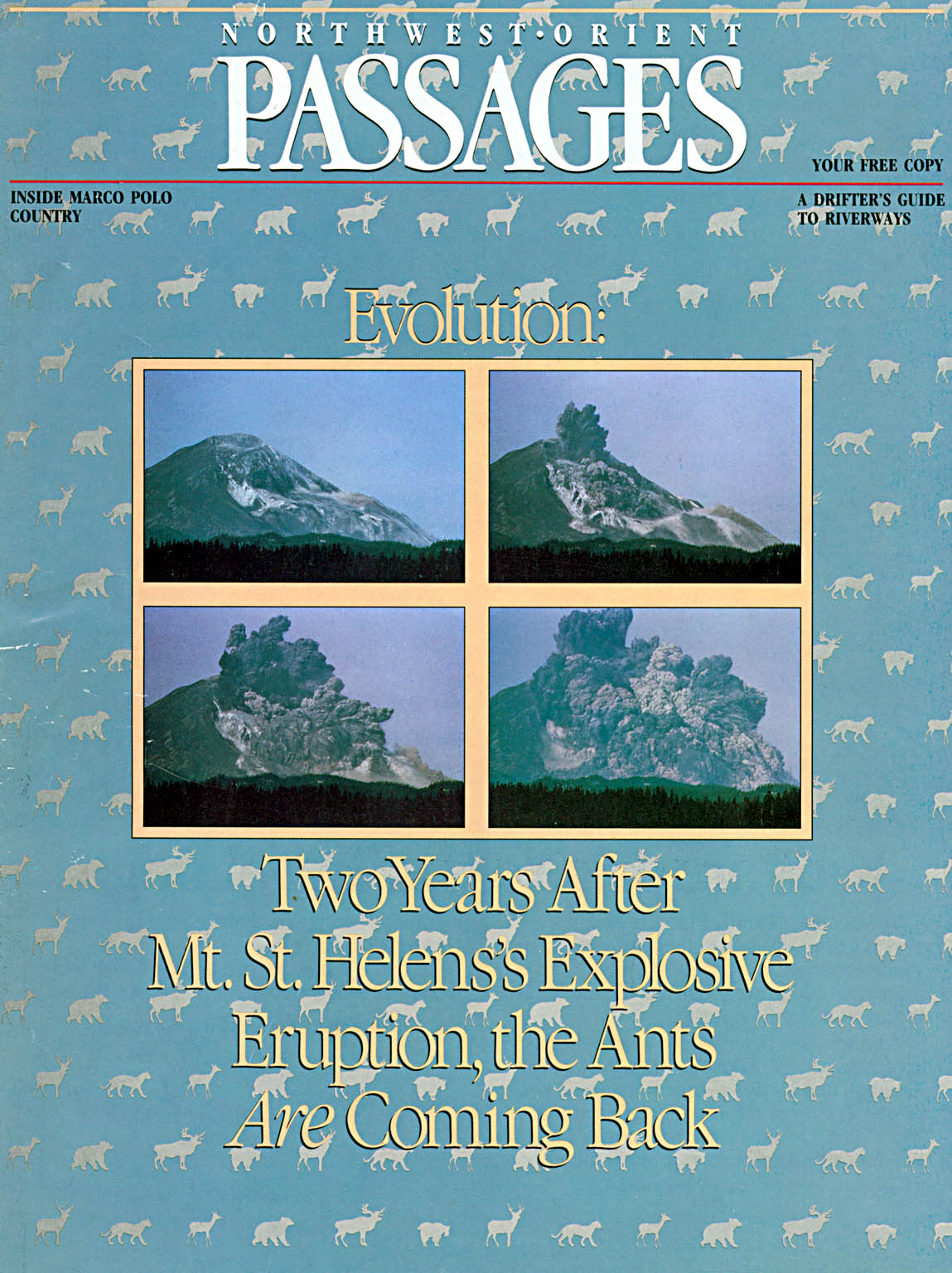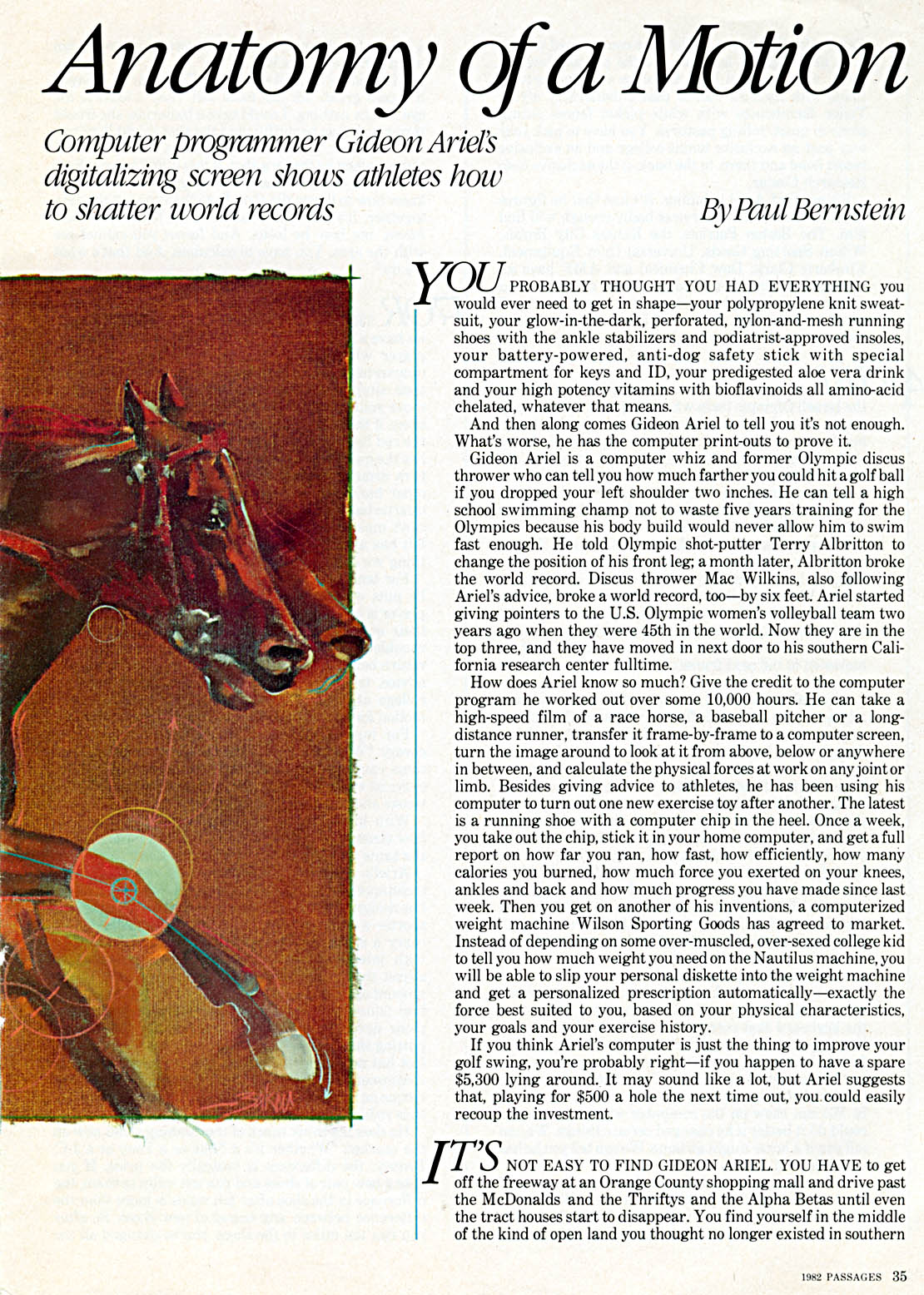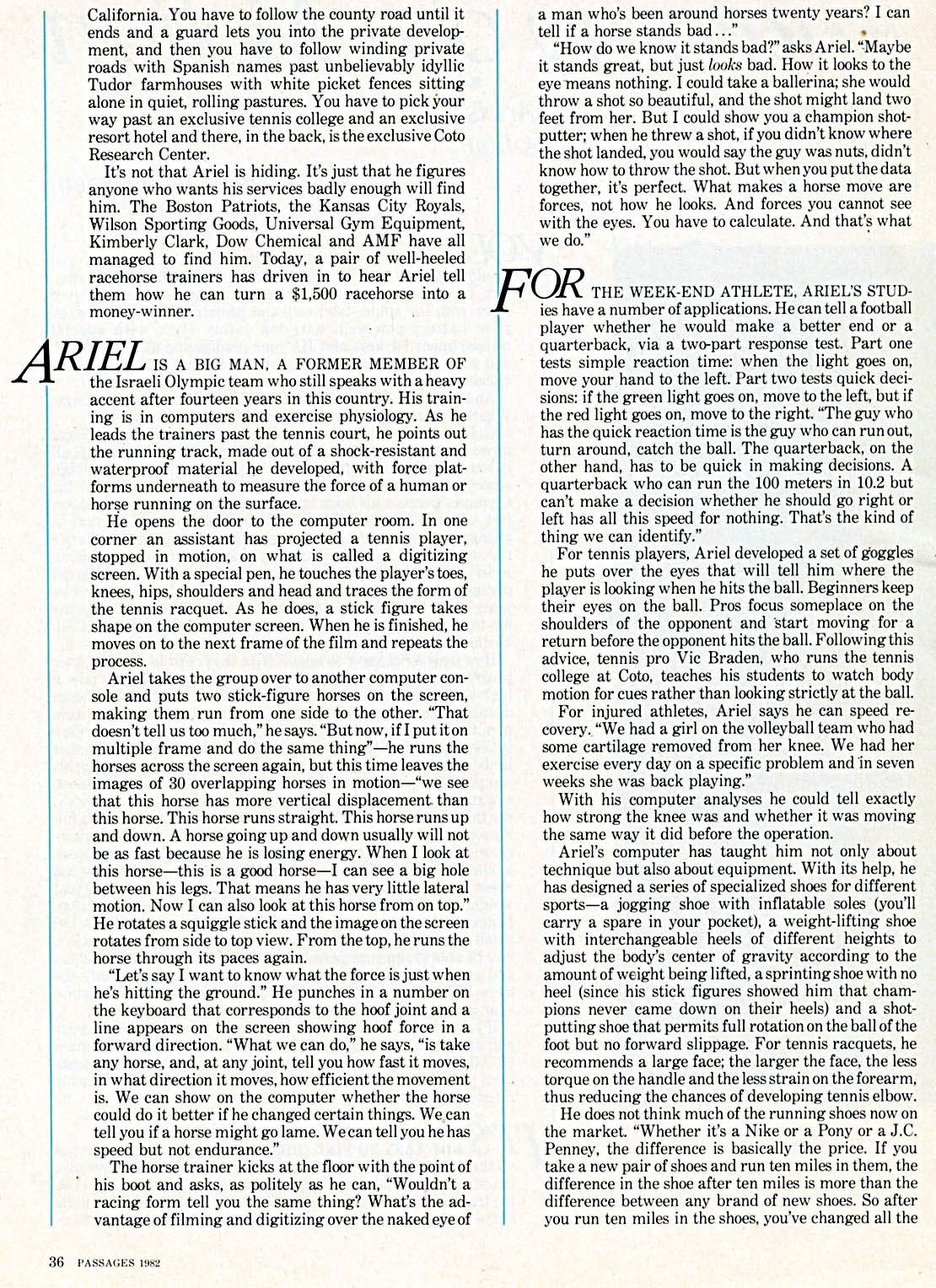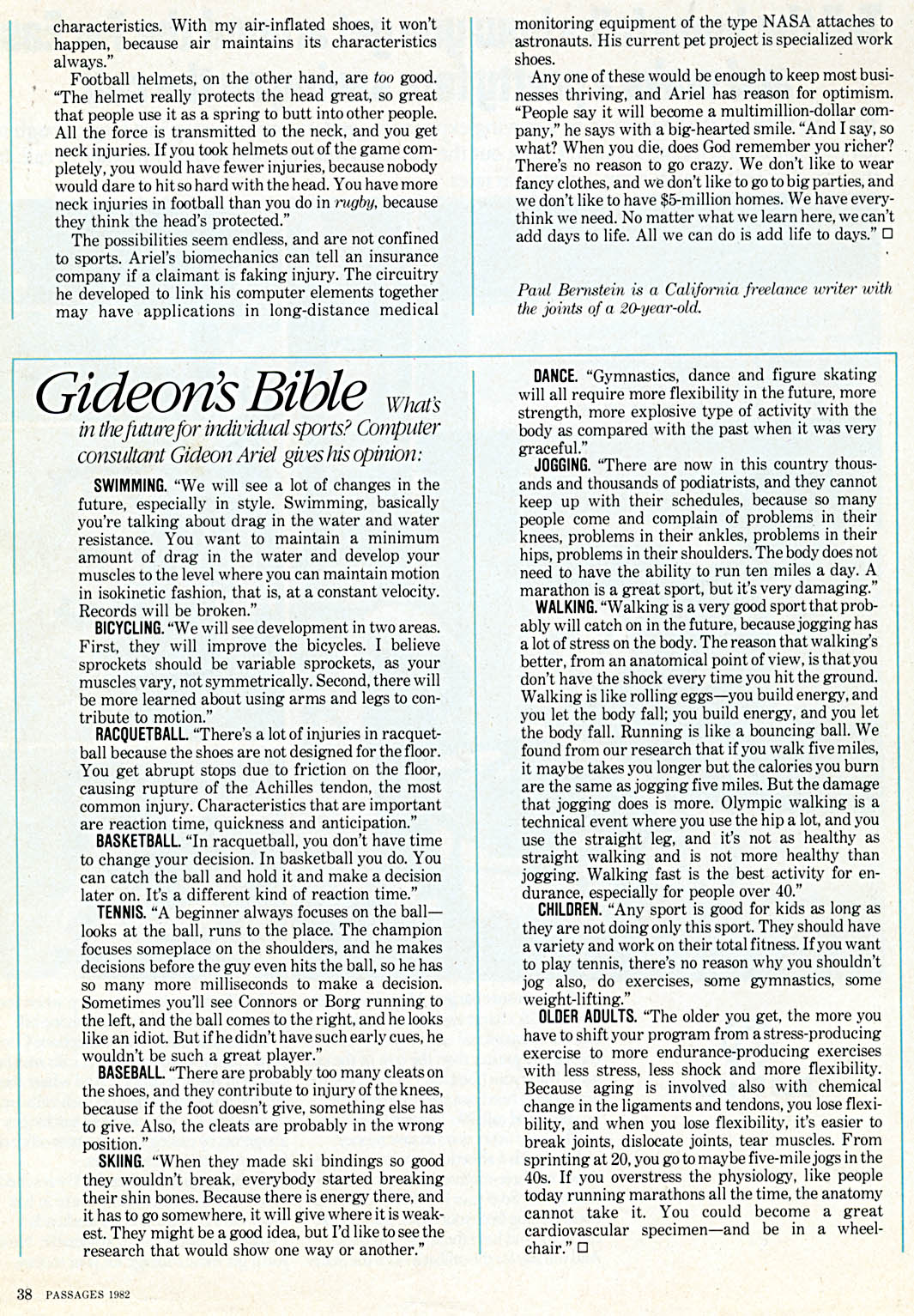Anatomy of a Motion
Computer programmer Gideon Ariel's digitalizing screen shows athletes how to shatter world records
By Paul Bernstein in Northwest-Orient Passages on Friday, January 1, 1982
Anatomy of Motion
In this article, Gideon Ariel, a computer programmer and former Olympic discus thrower, uses his computer program to help athletes improve their performance and break world records. Ariel's program can analyze high-speed films of athletes, digitize their movements, and calculate the physical forces at work on any joint or limb. This allows him to give precise advice on how to improve technique and performance. Ariel's program has also been used to design new exercise equipment and specialized shoes for different sports. His work has been sought after by various sports teams and companies, including the Boston Patriots, the Kansas City Royals, and Wilson Sporting Goods.
Tip: use the left and right arrow keys
Anatomy of Motion
Computer proglummer Gideon Ariels
digitalizing screen show athletes how to shatter world records BvPai ii Ben istein
YOU PROBABLY THOUGHT YOU HAD EVERYTHING you would ever need to get in shape-your polypropylene knit sweatsuit, your glow-in-the-dark, perforated, nylon-and-mesh running shoes with the ankle stabilizers and podiatrist-approved insoles, your battery-powered, anti-dog safety stick with special compartment for keys and ID, your predigested aloe vera drink and your high potency vitamins with bioflavinoids all amino-acid chelated, whatever that means.
And then along comes Gideon Ariel to tell you it's not enough. What's worse, he has the computer print-outs to prove it.
Gideon Ariel is a computer whiz and former Olympic discus thrower who can tell you how much farther you could hit a golf ball if you dropped your left shoulder two inches. He can tell a high school swimming champ not to waste five years training for the Olympics because his body build would never allow him to swim fast enough. He told Olympic shot-putter Terry Albritton to change the position of his front leg; a month later, Albritton broke the world record. Discus thrower Mac Wilkins, also following Ariel's advice, broke a world record, too-by six feet. Ariel started giving pointers to the U.S. Olympic women's volleyball team two years ago when they were 45th in the world. Now they are in the top three, and they have moved in next door to his southern California research center fulltime.
How does Ariel know so much? Give the credit to the computer program he worked out over some 10,000 hours. He can take a high-speed film of a race horse, a baseball pitcher or a longdistance runner, transfer it frame-by-frame to a computer screen, turn the image around to look at it from above, below or anywhere in between, and calculate the physical forces at work on any joint or limb. Besides giving advice to athletes, he has been using his computer to turn out one new exercise toy after another. The latest is a running shoe with a computer chip in the heel. Once a week, you take out the chip, stick it in your home computer, and get a full report on how far you ran, how fast, how efficiently, how many calories you burned, how much force you exerted on your knees, ankles and back and how much progress you have made since last week. Then you get on another of his inventions, a computerized weight machine Wilson Sporting Goods has agreed to market. Instead of depending on some over-muscled, over-sexed college kid to tell you how much weight you need on the Nautilus machine, you will be able to slip your personal diskette into the weight machine and get a personalized prescription automatically-exactly the force best suited to you, based on your physical characteristics, your goals and your exercise history.
If you think Ariel's computer is just the thing to improve your golf swing, you're probably right-if you happen to have a spare $5,300 lying around. It may sound like a lot, but Ariel suggests that, playing for $500 a hole the next time out, you could easily recoup the investment.
NOT EASY TO FIND GIDEON ARIEL YOU HAVE to get off the freeway at an Orange County shopping mall and drive past the McDonalds and the Thriftys and the Alpha Betas until even the tract houses start to disappear. You find yourself in the middle of the kind of open land you thought no longer existed in southern
I9?2 PASSM;F:s 35
California. You have to follow the county road until it ends and a guard lets you into the private development, and then you have to follow winding private roads with Spanish names past unbelievably idyllic Tudor farmhouses with white picket fences sitting alone in quiet, rolling pastures. You have to pick your way past an exclusive tennis college and an exclusive resort hotel and there, in the back, is the exclusive Coto Research Center.
It's not that Ariel is hiding. It's just that he figures anyone who wants his services badly enough will find him. The Boston Patriots, the Kansas City Royals, Wilson Sporting Goods, Universal Gym Equipment, Kimberly Clark, Dow Chemical and AMF have all managed to find him. Today, a pair of well-heeled racehorse trainers has driven in to hear Ariel tell them how he can turn a $1,500 racehorse into a money-winner.
ARIEL IS A BIG MAN, A FORMER MEMBER F
the Israeli Olympic team who still speaks with a heavy accent after fourteen years in this country. His training is in computers and exercise physiology. As he leads the trainers past the tennis court, he points out the running track, made out of a shock-resistant and waterproof material he developed, with force platforms underneath to measure the force of a human or horse running on the surface.
He opens the door to the computer room. In one corner an assistant has projected a tennis player, stopped in motion, on what is called a digitizing screen. With a special pen, he touches the player's toes, knees, hips, shoulders and head and traces the form of the tennis racquet. As he does, a stick figure takes shape on the computer screen. When he is finished, he moves on to the next frame of the film and repeats the process.
Ariel takes the group over to another computer console and puts two stick-figure horses on the screen, making them run from one side to the other. "That doesn't tell us too much," he says. "But now, if I put iton multiple frame and do the same thing"-he runs the horses across the screen again, but this time leaves the images of 30 overlapping horses in motion-"we see that this horse has more vertical displacement than this horse. This horse runs straight. This horse runs up and down. A horse going up and down usually will not be as fast because he is losing energy. When I look at this horse-this is a good horse-I can see a big hole between his legs. That means he has very little lateral motion. Now I can also look at this horse from on top." He rotates a squiggle stick and the image on the screen rotates from side to top view. From the top, he runs the horse through its paces again.
"Let's say I want to know what the force is just when he's hitting the ground." He punches in a number on the keyboard that corresponds to the hoof joint and a line appears on the screen showing hoof force in a forward direction. "What we can do," he says, "is take any horse, and, at any joint, tell you how fast it moves, in what direction it moves, how efficient the movement is. We can show on the computer whether the horse could do it better if he changed certain things. We can tell you if a horse might go lame. We can tell you he has speed but not endurance."
The horse trainer kicks at the floor with the point of his boot and asks, as politely as he can, "Wouldn't a racing form tell you the same thing? What's the advantage of filming and digitizing over the naked eye of a man who's been around horses twenty years? I can tell if a horse stands bad..."
"How do we know it stands bad?" asks Ariel. "Maybe it stands great, but just looks bad. How it looks to the eye means nothing. I could take a ballerina; she would throw a shot so beautiful, and the shot might land two feet from her. But I could show you a champion shotputter; when he threw a shot, if you didn't know where the shot landed, you would say the guy was nuts, didn't know how to throw the shot. But when you put the data together, it's perfect. What makes a horse move are forces, not how he looks. And forces you cannot see with the eyes. You have to calculate. And that's what we do."
OR THE WEEK-END ATHLETE, ARIEL'S STUD
ies have a number of applications. He can tell a football player whether he would make a better end or a quarterback, via a two-part response test. Part one tests simple reaction time: when the light goes on, move your hand to the left. Part two tests quick decisions: if the green light goes on, move to the left, but if the red light goes on, move to the right. "The guy who has the quick reaction time is the guy who can run out, turn around, catch the ball. The quarterback, on the other hand, has to be quick in making decisions. A quarterback who can run the 100 meters in 10.2 but can't make a decision whether he should go right or left has all this speed for nothing. That's the kind of thing we can identify."
For tennis players, Ariel developed a set of goggles he puts over the eyes that will tell him where the player is looking when he hits the ball. Beginners keep their eyes on the ball. Pros focus someplace on the shoulders of the opponent and start moving for a return before the opponent hits the ball. Following this advice, tennis pro Vie Braden, who runs the tennis college at Coto. teaches his students to watch body motion for cues rather than looking strictly at the ball.
For injured athletes, Ariel says he can speed recovery. "We had a girl on the volleyball team who had some cartilage removed from her knee. We had her exercise every day on a specific problem and 'in seven weeks she was back playing."
With his computer analyses he could tell exactly how strong the knee was and whether it was moving the same way it did before the operation.
Ariel's computer has taught him not only about technique but also about equipment. With its help, he has designed a series of specialized shoes for different sports-a jogging shoe with inflatable soles (you'll carry a spare in your pocket), a weight-lifting shoe with interchangeable heels of different heights to adjust the body's center of gravity according to the amount of weight being lifted, a sprinting shoe with no heel (since his stick figures showed him that champions never came down on their heels) and a shotputting shoe that permits full rotation on the ball of the foot but no forward slippage. For tennis racquets, he recommends a large face; the larger the face, the less torque on the handle and the less strain on the forearm, thus reducing the chances of developing tennis elbow.
lie does not think much of the running shoes now on the market. "Whether it's a Nike or a Pony or a J.C. Penney, the difference is basically the price. If you take a new pair of shoes and run ten miles in them, the difference in the shoe after ten miles is more than the difference between any brand of new shoes. So after you run ten miles in the shoes, you've changed all the
36 PASSAGES
characteristics. With my air-inflated shoes, it won't happen, because air maintains its characteristics always."
Football helmets, on the other hand, are too good. "The helmet really protects the head great, so great that people use it as a spring to butt into other people. All the force is transmitted to the neck. and you get neck injuries. If you took helmets out of the game completely, you would have fewer injuries, because nobody would dare to hit so hard with the head. You have more neck injuries in football than you do in rugby, because they think the head's protected."
The possibilities seem endless, and are not confined to sports. Ariel's biomechanics can tell an insurance company if a claimant is faking injury. The circuitry he developed to link his computer elements together may have applications in long-distance medical
Gideons Bible ~~ ,1111 S
N1 the/llhuv/Ul'llllr'll'1(11tal s orts~ X111 ifntier co; isilllliiit Gkleo;i Arid [t;il 'S his (phliOll:
SWIMMING. "We will see a lot of changes in the future, especially in style. Swimming, basically you're talking about drag in the water and water resistance. You want to maintain a minimum amount of drag in the water and develop your muscles to the level where you can maintain motion in isokinetic fashion, that is, at a constant velocity. Records will be broken."
BICYCLING. "We will see development in two areas. First, they will improve the bicycles. I believe sprockets should be variable sprockets, as your muscles vary, not symmetrically. Second, there will be more learned about using arms and legs to contribute to motion."
RACQUETBALL "There's a lot of injuries in racquetball because the shoes are not designed for the floor. You get abrupt stops due to friction on the floor, causing rupture of the Achilles tendon, the most common injury. Characteristics that are important are reaction time, quickness and anticipation."
BASKETBALL "In racquetball, you don't have time to change your decision. In basketball you do. You can catch the ball and hold it and make a decision later on. It's a different kind of reaction time."
TENNIS. "A beginner always focuses on the balllooks at the ball, runs to the place. The champion focuses someplace on the shoulders, and he makes decisions before the guy even hits the ball, so he has so many more milliseconds to make a decision. Sometimes you'll see Connors or Borg running to the left, and the ball comes to the right, and he looks like an idiot. But if he didn't have such early cues, he wouldn't be such a great player."
BASEBALL "There are probably too many cleats on the shoes, and they contribute to injury of the knees, because if the foot doesn't give, something else has to give. Also, the cleats are probably in the wrong position."
SKIING. "When they made ski bindings so good they wouldn't break, everybody started breaking their shin bones. Because there is energy there, and it has to go somewhere, it will give where it is weakest. They might be a good idea, but I'd like to see the research that would show one way or another."
monitoring equipment of the type NASA attaches to astronauts. His current pet project is specialized work shoes.
Any one of these would be enough to keep most businesses thriving, and Ariel has reason for optimism. "People say it will become a multimillion-dollar company," he says with a big-hearted smile. "And I say, so what? When you die, does God remember you richer? There's no reason to go crazy. We don't like to wear fancy clothes, and we don't like to go to big parties, and we don't like to have $.)-million homes. We have everythink we need. No matter what we learn here, we can't add days to life. All we can do is add life to days." 0
/'oul Bernstein is a California freelance writer u�itli t/uc joints of a ,at-)-tear-old.
DANCE. "Gymnastics, (lance and figure skating will all require more flexibility in the future, more strength, more explosive type of activity with the body as compared with the past when it was very graceful."
JOGGING. "There are now in this country thousands and thousands of podiatrists, and they cannot keep up with their schedules, because so many people come and complain of problems in their knees, problems in their ankles, problems in their hips, problems in their shoulders. The body does not need to have the ability to run ten miles a day. A marathon is a great sport, but it's very damaging."
WALKING. "Walking is a very good sport that probably will catch on in the future, because joggi rig has a lot of stress on the body. The reason that walking's better, from an anatomical point of view, is that you don't have the shock every time you hit the ground. Walking is like rolling eggs-you build energy, and you let the body fall; you build energy, and you let the body fall. Running is like a bouncing ball. We found from our research that if you walk five miles, it maybe takes you longer but the calories you burn are the same as jogging five miles. But the damage that jogging does is more. Olympic walking is a technical event where you use the hip a lot, and you use the straight leg, and it's not as healthy as straight walking and is not more healthy than jogging. Walking fast is the best activity for endurance, especially for people over 40."
CHILDREN. "Any sport is good for kids as long as they are not doing only this sport. They should have a variety and work on their total fitness. If you want to play tennis, there's no reason why you shouldn't jog also, do exercises, some gymnastics, some weight-lifting."
OLDER ADULTS. "The older you get, the more you have to shift your program from a stress-producing exercise to more endurance-producing exercises with less stress, less shock and more flexibility. Because aging is involved also with chemical change in the ligaments and tendons, you lose flexibility, and when you lose flexibility, it's easier to break joints, dislocate joints, tear muscles. From sprinting at 20. you go to maybe five-mile jogs in the 40s. If you overstress the physiology, like people today running marathons all the time, the anatomy cannot take it. You could become a great cardiovascular specimen-and be in a wheelchair." 0
38 PASSAGES 19r'1





